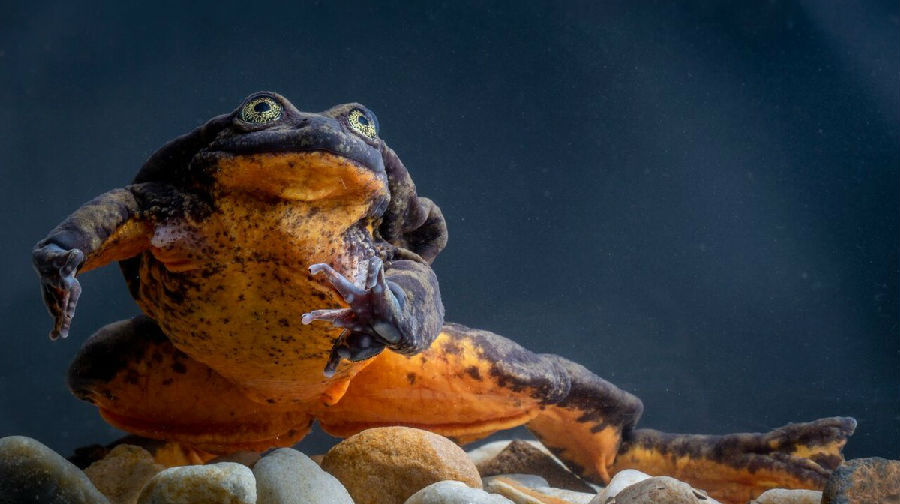(单词翻译:单击)
听力文本
Scientists Report 'Dating' Progress between Rare Frog and Mate
Scientists say two rare water frogs had a long-awaited first "date" and showed signs of mating, which could help save the species.
The two are critically endangered Sehuencas water frogs, native to Bolivia. The male, named Romeo, was considered the last known living member of the species when he was collected from the wild 11 years ago.
But that changed in January, when researchers announced that five additional Sehuencas water frogs had been found. That discovery was made by researchers from Global Wildlife Conservation and Bolivia's Alcide d'Orbigny Natural History Museum.
The find came after the team increased its search activities in an urgent effort to find a mate for Romeo.
Bolivia has a large number of amphibian species. But Global Wildlife Conservation reports that 22 percent of them — including 10 of 14 kinds of water frogs — face serious threats of disappearing from the planet. Experts blame several causes for the decrease in numbers, including destruction of habitat, the introduction of non-native species, climate change and a deadly disease called chytridiomycosis.
Among the five newly discovered frogs were three females, one of which was identified as a possible ideal partner for Romeo. Scientists named her Juliet.
After months of observation at the natural history museum, officials confirmed that Juliet was free of disease. Then, on March 1, she and Romeo were put into a tank that was new to both of them. After more observation, museum officials decided to move Juliet into Romeo's former tank. They believed the move would improve conditions for mating.
Teresa Camacho Badani works with amphibians at the museum. She said in a statement that officials believed it was important to begin the mating process right away. "When the fate of an entire species is on the line, there's really no time for taking it slow before committing to moving in together."
She added, "Romeo has been really sweet to Juliet." For example, the male frog has been following her around the tank and sacrificing some of his food to her, Badani said. "After he's been alone for so long, it's wonderful to see him with a mate finally."

Museum officials say one of the first hopeful signs was a change in Romeo's calling behavior. He had not been heard making calling sounds since the end of 2017. But he started making the noises again shortly after the pair got moved into Romeo's tank.
Since meeting Juliet, Romeo has also been doing something that experts say has never been seen before in this species group. Romeo has been observed quickly moving the toes on his back feet when he's near Juliet. The experts say this species-specific performance is likely an attempt by the male to impress the female.
Although there are signs that Romeo is interested in mating, Badani says he still has some things to learn. The museum reports that so far, he has gotten himself in the correct mating position only a few times for a few minutes.
The mating process involves the male frog holding the female in a certain way, long enough to fertilize her eggs. Generally, mating can only be successful when both frogs stay in position for weeks, or even months. But wildlife experts admit they know very little about the reproductive behavior of this species.
Chris Jordan is head of Global Wildlife Conservation's operations in Central America and the Tropical Andes. He said in a statement that it is not known how long the mating process would last for Sehuencas frogs. His team is also not sure how long the eggs would take to develop or how many might be produced.
"For now we're keeping them together, and observing them," he said. "Which as simple as it sounds, is already revealing previously unknown behaviors and answering natural history questions about this relatively unknown species."
Jordan added that the experiment was another example of "how little we know about a lot of the species with which we share this planet."
The public can follow Romeo and Juliet's progress on Facebook.
I'm Bryan Lynn.
重点解析
重点讲解:
1. be free of 无…的;摆脱了…的;
She retains her slim figure and is free of wrinkles.
她保持着苗条的身材,脸上也没有皱纹。
2. right away 立刻;立即;马上;
Mick wants to see you in his office right away.
米克要你马上去他的办公室见他。
3. on the line 岌岌可危;冒极大的险;
He wouldn't put his career on the line to help a friend.
他不会为了帮助朋友而让自己的事业受到威胁。
4. be interested in 感兴趣的;有兴趣的;关心的;
As a writer I am interested in characterization.
作为作家,我对人物塑造感兴趣。
参考译文
科学家报告称罕见水蛙和另一半的约会取得进展
科学家表示,两只罕见的水蛙进行了期待已久的首次“约会”,同时出现了交配迹象,这可能有助于保护这一物种。
这两只水蛙是极度濒危的西温克斯水蛙,原产于玻利维亚。雄性水蛙名为“罗密欧”,他于11年前在野外被发现,当时他被认为是地球上已知的最后一只西温克斯水蛙。
但是这在1月份发生了改变,当时研究人员宣布他们发现了另外5只西温克斯水蛙。发现者是世界野生动物保护协会和玻利维亚阿尔希德·德奥比自然历史博物馆的研究人员。
该团队在执行为罗密欧寻找另一半的迫切任务时增加了搜索行动,随后有了这一重大发现。
玻利维亚拥有大量两栖物种。但是世界野生动物保护协会的报告显示,其中22%的物种面临着从地球上消失的严重威胁,这包括14种水蛙中的10种。专家认为这些物种数量下降有多种原因,包括栖息地的破坏、非本土物种的引入、气候变化以及致命疾病壶菌病的侵袭。
新发现的5只水蛙中有3只雌性,其中一只被确定为罗密欧可能的理想伴侣。科学家将这只雌性水蛙命名为朱丽叶。
在该自然历史博物馆进行了数个月的观察之后,官员确认朱丽叶没有染病。3月1日,她和罗密欧被放入一个水箱中,这个水箱对两只水蛙来说是全新的环境。在进行更多观察之后,博物馆官员决定将朱丽叶放入罗密欧此前生活的水箱中。他们认为这样做会改善交配条件。
特丽萨·卡马乔·巴达尼在博物馆的两栖动物馆工作。她在声明中表示,官员认为这对立刻开始交配过程非常重要。“当一个物种的命运已经岌岌可危时,没有时间先缓慢行动再让它们住到一起。”
她还表示,“罗密欧一直对朱丽叶很温柔。”巴达尼说,举个例子,罗密欧一直追随着朱丽叶在水箱各处活动,他还将自已的食物送给朱丽叶。“罗密欧已经独自生活了太长时间,现在看到他终于有了另一半真是太好了。”
博物馆官员表示,其中一个首次出现的充满希望的迹象是,罗密欧的鸣叫行为发生了改变。自2017年底以来,他从未发出过叫声。但在朱丽叶被放入罗密欧的水箱之后,他再次发出了这种声音。
专家表示,自从见到朱丽叶之后,罗密欧还做了此前他们从未见到这一物种做过的事情。他们观察到,罗密欧在接近朱丽叶时会迅速活动后脚的脚趾。专家表示,这种具有物种特异性的行为很可能是罗密欧在试图打动朱丽叶。
巴达尼表示,尽管有迹象表明罗密欧想进行交配,但是他仍有一些东西要学。博物馆报告显示,截至目前,他几次让自已处于正确的交配位置,但时间只持续了几分钟。
交配过程包括,罗密欧要以一种特定的方式抱着朱丽叶,持续时间要足够让她的卵受精。通常来说,只有两只青蛙保持交配体位数周甚至数月的时间,交配才能成功。不过野生动物专家也承认,他们对这一水蛙物种的繁殖知之甚少。
克里斯·乔丹是世界野生动物保护协在中美洲和热带安地斯山脉所开展行动的负责人。他在声明中表示,目前并不清楚西温克斯水蛙的交配过程会持续多长时间。他的团队也不确定西温克斯水蛙的卵需要多长时间能发育以及它们会产多少卵。
他说,“目前,我们一直让它们住在一起,然后观察它们。虽然听上去很简单,但是这种做法已经揭示了此前未知的行为,同时解答了有关这种相对来说鲜为人知的物种的自然历史问题。”
乔丹还表示,这一实验再次证明,“对于这个和我们共同生活在地球上的物种,我们的了解竟然如此之少”。
公众可以在脸谱网上追踪罗密欧和朱丽叶的进展。
布莱恩·林恩报道。
译文为可可英语翻译,未经授权请勿转载!


